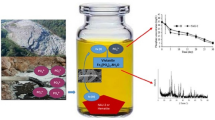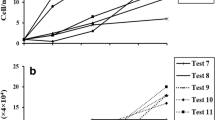Abstract
Bacterial leaching of metal sulphides is now recognized as an attractive industrial process and is successfully applied to recover copper from mixed and low grade sulphide ores. One of the main problems in the operation of bacterial leaching plants is the control of dissolved iron, generally present as a major impurity in all the treated sulphide ores.
The present study examines the behavior of the dissolved iron species in bacterial leaching systems and the different interactions observed between iron, bacteria and mineral solids. The rate of oxidation of ferrous iron by bacteria was studied for both free and attached bacteria, this showed a decrease of ferrous iron oxidation activity for bacteria attached to inorganic solids. On the other hand, the presence of attached bacteria on solid elemental sulphur and metal sulphides increases the reduction rate of ferric ions on the solid surface through oxido-reduction reactions.
In the presence of bacteria, the precipitation of oxidized ferric iron was increased and ferric ion precipitates even when the conditions in the bulk solution would permit its solubility. Moreover, the presence of solid particles increases iron precipitation. The precipitates were analyzed for iron and sulphate contents showing an iron/sulphate ratio very similar to that of jarosite. In the case of chemical precipitation of ferric ions by increasing pH, the sulphate content of the precipitate was lower, showing that in this case the precipitate was mainly ferric hydroxide.
Access this chapter
Tax calculation will be finalised at checkout
Purchases are for personal use only
Preview
Unable to display preview. Download preview PDF.
Similar content being viewed by others
References
Vargas T., Sanhuesa A. and Escobar B. (1992) Electrochemical studies of the bacterial leaching of pyrite with Thiobacillus ferrooxidans, in EPD Congress 1992 (ed. J.P. Hager), TMS 1992, pp 273–284
Wiertz J.V. (1993) Ferrous and sulfur oxidation by Thiobacillus ferrooxidans, in Biohydrometallurgical Technologies, vol II (ed. A.E. Torma, M.L. Apel and C.L. Brierley), TMS 1993, pp 463–471
Espejo R.T. and Romero P. (1987) Growth of hiobacillus ferrooxidans on elemental sulfur, Applied Environmental Microbiology, S3, 1907–1912
Muir M.K. and Andersen T.N. (1977) Determination of ferrous iron in copper-process metallurgical solutions by the o-phenanthroline colorimetric method, Metallurgical Transactions, 8B, 317–518
DiSpirito A.A., Dungan P.R. and Tuovinen O.H. (1983) Inhibitory effects of particulate materials in growing culture of Thiobacillus ferrooxidans, Biotechnology and Bioengineering, 25, 1163–1168
Kai T., Takahashi T., Shirakawa Y. and Kawabata Y. (1990) Decrease in iron oxidizing activity of Thiobacillus ferrooxidans adsorbed on activated carbon, Biotechnology and Bioengieneering, 36, 1105–1109
Aguirre R., Wiertz J.V. and Badilla-Ohlbaum R. (1991) An amperometric method for measuring iron oxidazing activity of Thiobacillus ferrooxidans, Bioleaching: from molecular biology to industrial applications (ed. R. Badilla-Ohlbaum, T. Vargas and L. Herrera), University of Chile, Santiago, Chile, pp 107–117
Wiertz J.V. (1992) Lixiviation bactérienne de la chalcopyrite: role et importance du fer, Thèse de Doctorat, Université de Liège, Belgium
Sugio T., Katagiri T., Moriyama M., Zhen Y.L. Inagaki K. and Tano T. (1988) Existence of a new type of sulfite oxidase which utilizes ferric ions as an electron acceptor in Thiobacillus ferrooxidans, Applied Environmental Microbiology, 54, 153–157
White, Shute E., Choate D. and Blake R.C. (1992) Existence of a hydrogen sulfide:ferric ion oxidoreductase in iron oxidizing bacteria, Applied Environmental Microbiololy, 58, 431–433
Sugio T., Hirose T, Oto A., Inagaki K. and Tano T. (1989) The regulation of sulfur utilization by ferrous ion in Thiobacillus ferrooxidans, in Biohydrometallurgy 1989 (ed. J. Salley, R.G.L. McGready and P.L. Wichlacz), Canmet, Ottawa, Canada, pp 451–459
Gaete M., Flores, I., Campos J., Lara E., Razmilic L., Guerrero P., Wiertz J. and Maturana H. (1990) Comparación entre la lixiviación química por sulfato férrico y lixiviación bacteriana en el pretratamiento de un concentrado aurifero refractario, in Iberomet-Conamet VI, USACH, Santiago, Chile, pp 423–433
Author information
Authors and Affiliations
Rights and permissions
Copyright information
© 1994 Springer Science+Business Media Dordrecht
About this chapter
Cite this chapter
Wiertz, J.V., Ríos, I.G., Miguel, B.E. (1994). Dissolved iron equilibrium in bacterial leaching systems. In: Hydrometallurgy ’94. Springer, Dordrecht. https://doi.org/10.1007/978-94-011-1214-7_24
Download citation
DOI: https://doi.org/10.1007/978-94-011-1214-7_24
Publisher Name: Springer, Dordrecht
Print ISBN: 978-94-010-4532-2
Online ISBN: 978-94-011-1214-7
eBook Packages: Springer Book Archive




